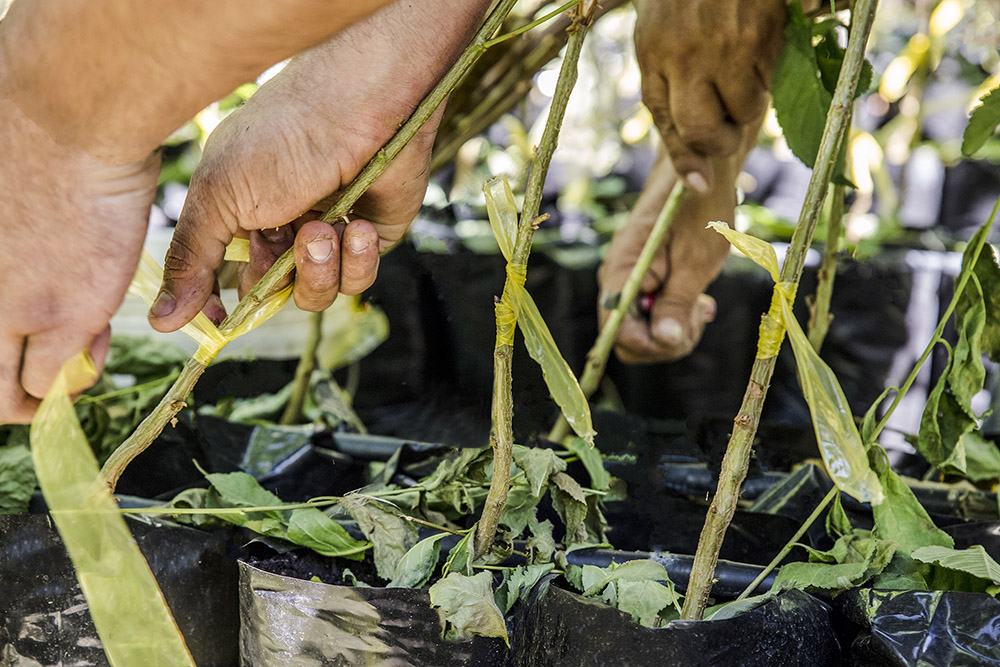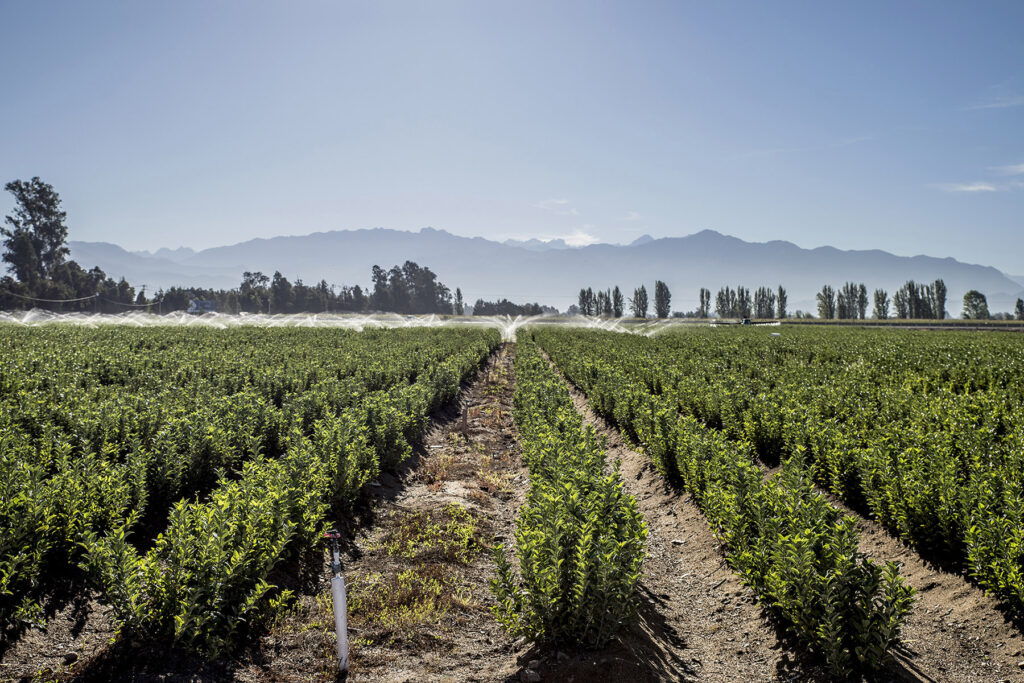
-
56 72 2712 249 | 56 72 2715 931
56 72 2713 556 | 56 272 719 718 - secretaria@losolmos.cl
- La Orilla, lot A - C, Chimbarongo

Our long history, and recognition of a job well done, supports us in the fruit production of apple, pear, cherry and kiwi plants of the best quality on the market.
And because we care to follow the path of innovation and the Forefront, we have recently added the hazelnut program to our productions
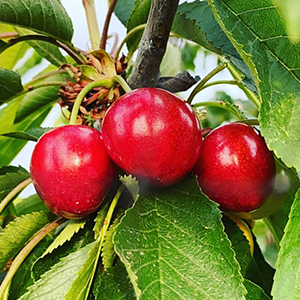
Source: California, USA.
Self-fertility: Self-incompatible.
Growth habit: Medium vigor.
Caliber: large 30-32 mm.
Harvest date: Santina -16 to -18 days.
Color: mahogany red, dark red flesh.
Splitting: sensitive to rain.
early

Source: California, USA.
Self-fertility: Self-compatible.
Growth habit: Medium-high vigor.
Caliber: 28-30 mm.
Harvest date: Santina -14 days.
Splitting: Sensitive to rain.
early
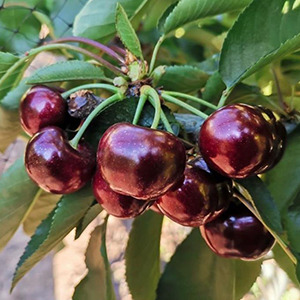
Source: Italy.
Self-fertility: Self-compatible.
Growth habit: High vigor, very good productivity.
Caliber: 28-30 mm.
Harvest date: Santina -12 to -14 days.
early
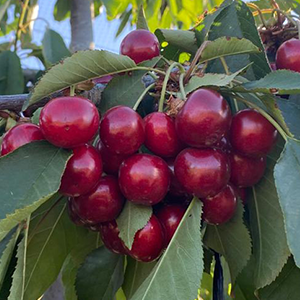
Source: California, USA.
Self-fertility: Compatible, a pollinator is still recommended.
Growth habit: Medium-high vigor, good firmness.
Caliber: Well, 28-30mm.
Harvest date: -7 to -10 days.
Splitting: Medium resistance to rain.
early
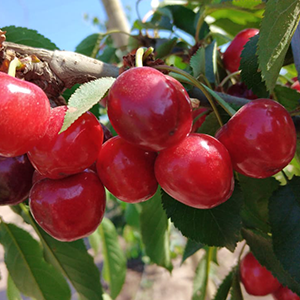
Source: Italy.
Self-fertility: Self-incompatible.
Growth habit: High vigor, high productivity.
Caliber: Large, 30 mm.
Harvest date:: Santina -7 to -10 days.
Splitting: Medium-low susceptibility to rain.
early
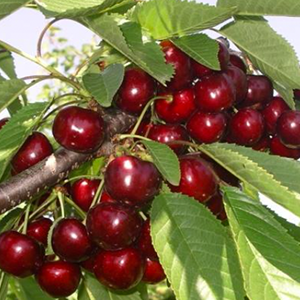
Self-fertility: Self-incompatible, high production.
Caliber: Large, 30 mm.
Growth habit: Medium-high vigor.
Harvest date:: Santina -5 to -7 days.
early

Source: Italy.
Self-fertility: Self-incompatible.
Growth habit: High vigor, high caliber (30-32 mm).
Color: Bright red to bright purple red.
Harvest date: Santina.
Splitting: Sensitive to rain.
early
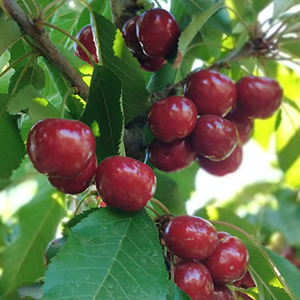
Source: Italy.
Self-fertility: Self-incompatible.
Growth habit: High vigor, high productivity.
Caliber: Very large, 32-34 mm.
Color: Symmetrical fruit, bright red to purple.
Harvest date: Lapins -7 to -10.
early
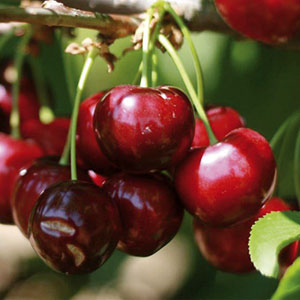
Source: Canada.
Caliber::
Medium large, 26-30mm.
Flavor and firmness: Sweet (18 to 22° Brix) and firm.
Pedicel: Medium.
Tree: Semi-vigorous, semi-erect.
Pollination: Self-fertile.
Splitting: Sensitive.
early
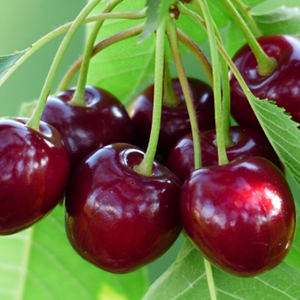
Source: Summerland 1983 (Van x Stella).
Harvest date: 5 to 10 days after Bing, less late than expected.
Caliber: Large, 25-28 mm.
Flavor and firmness: Good flavor and firmness, but inferior to Bing.
Pedicel: Medium.
Tree: Vigorous and erect, with regular branching and high concentration of the first ring productions (studs).
Pollination: Early flowering, self-fertile and good pollinator.
Harvest - Postharvest: Greater susceptibility to pitting than Bing, but less than Van.
Splitting: Medium susceptibility.
mid station
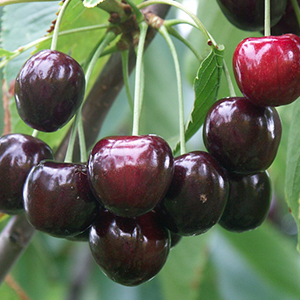
Source:Canada.
Caliber::
Large, 28 - 30 mm.
Flavor and firmness: Sweet (17° Brix) and good firmness.
Tree: Semi-extended, early.
Pollination: Self-fertile.
Harvest - Postharvest: Medium postharvest life.
Splitting: Tolerant.
mid station
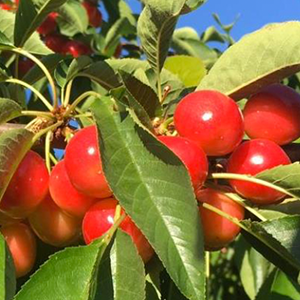
Source: USA.
Self-fertility: Self-incompatible, medium-high production.
Color: Two-color fruit.
Caliber::
27-30 mm.
Harvest date: Rainier.
mid station

Self-fertility: Self-incompatible, medium production.
Caliber: Large, 32 mm.
Color: Mahogany red.y
Harvest date: Between Rainier and Bing.
mid station
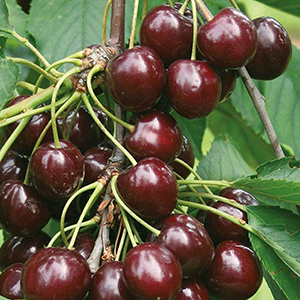
Source: Canada.
Caliber::
Large, 30 mm.
Flavor and firmness: Very sweet and medium firm.
Tree: Semi-vigorous, semi-erect and very early.
Pollination: Self-fertile.
Harvest - Postharvest: Good postharvest life.
Splitting: Susceptible.
late onset
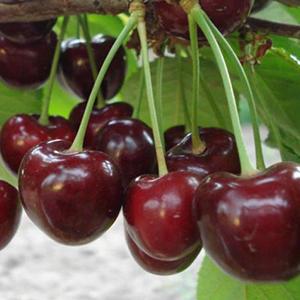
Source: Canada.
Caliber:
Large, 30 mm.
Flavor and firmness: Sweet and variable firmness according to size.
Tree: Vigorous, semi-erect and not very early.
Pollination: Bing, Van, Sunburst.
Harvest - Postharvest: Medium postharvest life.
Splitting: Medium susceptibility.
late onset
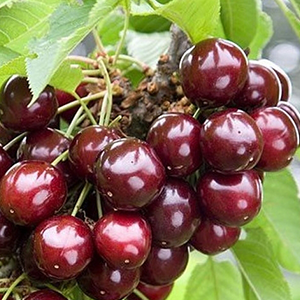
Source: Canada.
Caliber:
Large, 28 mm.
Flavor and firmness: Regular flavor and medium firmness.
Tree: Semi-vigorous, with semi-erect growth.
Pollination: Sunburst.
Harvest - Postharvest: Good postharvest.
late onset
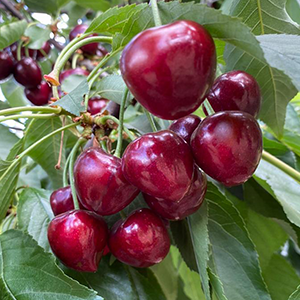
Source: Germany.
Self-fertility: Self-incompatible.
Parental: Kordia x Regina.
Growth habit: Medium vigor, medium and constant productivity.
Color:: Fruit similar to Kordia in color and size (30 mm).
Harvest date: Kordia.
late onset
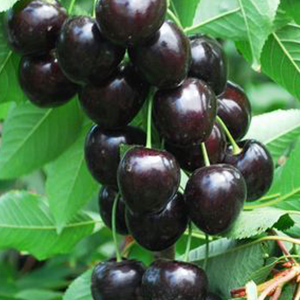
Source: Czechoslovakia, 1963 (random seed).
Harvest date: 6-8 days after Bing.
Caliber: Large, 25-27 mm.
Flavor and firmness: Excellent, good sweetness-acidity balance and very consistent (“meaty”).
Pedicel: Long.
Tree: Vigorous and very branching; little precocious and regular productivity due to insufficient final fruit set.
Pollination: Late intermediate flowering, pollinating Summit, Stella, Lambert, Hedelfingen, Regina.
Harvest - Postharvest: Good like Bing; pedicels become dehydrated more easily.
Splitting: Quite resistance.
late onset

Source: Italy.
Self-fertility: Self-compatible, high and constant productivity.
Caliber: Large, 30-32 mm.
Splitting: High susceptibility to rain.
Harvest date: Kordia.
late onset
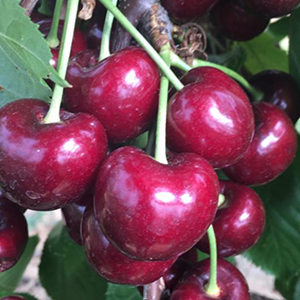
Source: Italy.
Self-fertility: Self-compatible, high and constant productivity.
Caliber: Large, 32 mm.
Splitting: High susceptibility to rain.
Harvest date: 3 days before Regina.
late onset

Source: Hamburg, Germany, 1981 (Schneider’s x Rube).
Harvest date: 1 week after Lapins (San Clemente).
Caliber: Large, 25-28 mm (grows last).
Flavor and firmness: Regular flavor and large stone, but very firm.
Pedicel: Long.
Tree: Semi vigorous, good branching and precocity.
Pollination: Late flowering, pollinating Kordia, Sam, Summit, Stella.
Harvest - Postharvest: Good experience in 1st export by sea to distant markets.
Splitting: Very good resistance.
late onset
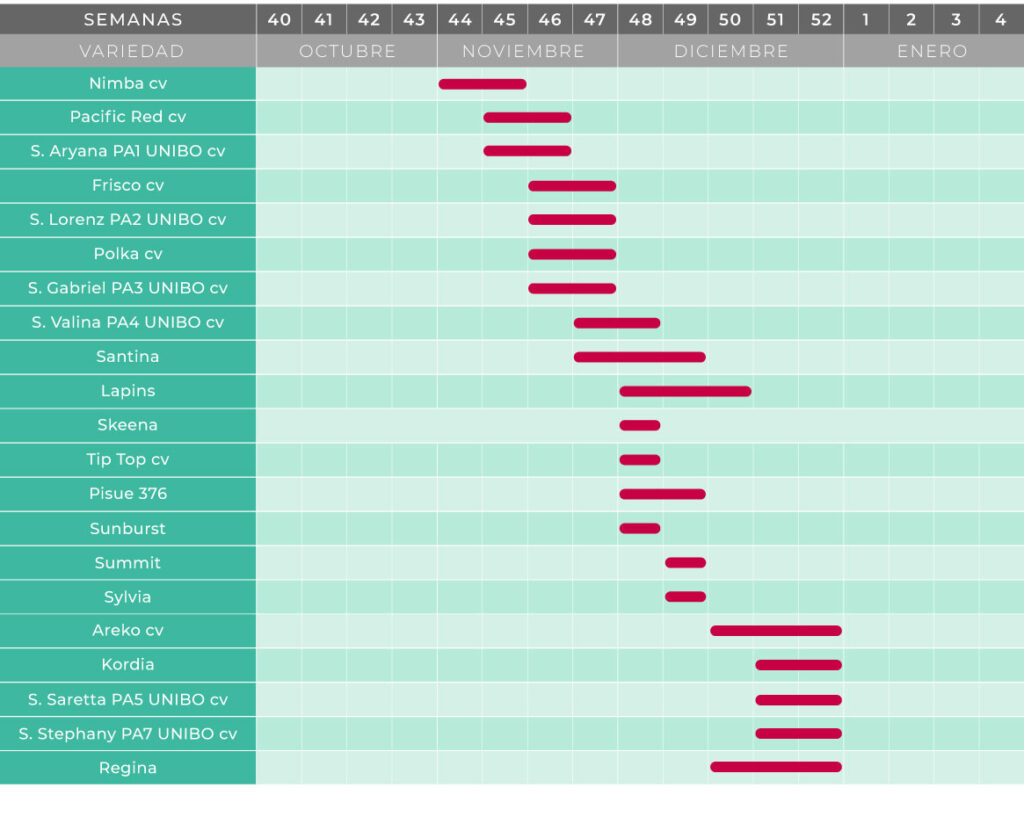
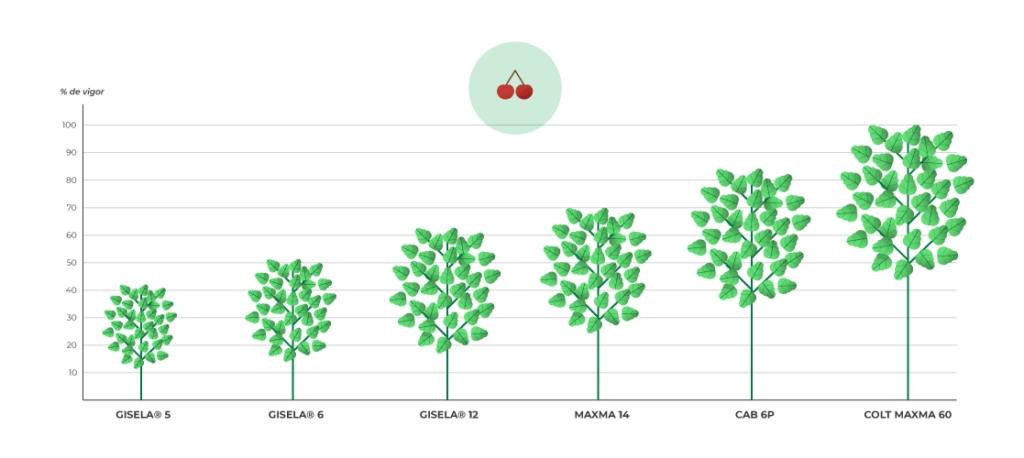
Rootstock with low vigor and a lot of precocity. Suitable for self-infertile varieties. It requires good quality soils.
Rootstock of medium vigor and very early maturity. Suitable for self-fertile varieties. It requires good quality soils.
Rootstock with vigor similar to MaxMa14 and very early.
Rootstock of medium vigor, confers precocity upon entry into production. Prefers loamy soils. It has a better adaptation with technical irrigation and greater adaptability to calcareous soils.
High vigor rootstock (similar to Colt), not susceptible to gall. Earlier than Colt at entry into production.
Vigorous rootstock. Recommended for medium-high fruit set varieties, self-fertile. Gill sensitive.
We currently offer 4 types of plant formats to be delivered to our clients:
Sleeping eye grafted plant on a one year old rootstock, in a 5 liter container.
Quality | Height |
|---|---|
Variety bud | 50 to 10 cm |
Rootstock already grafted from the start. Re-bred for a year to later be lowered.
Quality | No. of anticipated |
|---|---|
Super | +6 or more |
XL | 3 to 5 |
Plant in a spring container, which is reared during the spring - summer.
Quality | Height |
|---|---|
Super | > 1.8 mt |
XL | 1.8 to 1.6 mt |
L | 1.6 to 1.4 mt |
M | 1.4 to 1 mt |
Rootstock reared in the nursery the first year and grafted with the variety in the second year.
Quality | Height |
|---|---|
Super | > 1.9 mt |
XL | 1.9 to 1.7 mt |
L | 1.7 to 1.5 mt |
M | 1.5 to 1.3 mt |
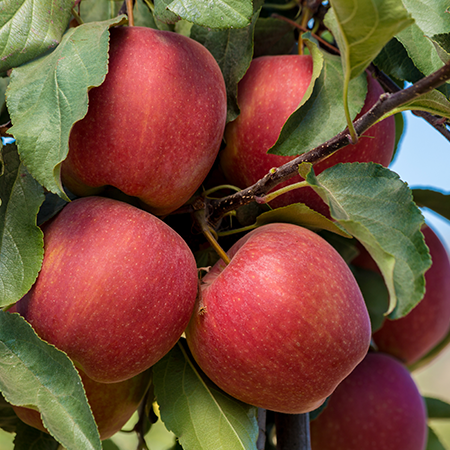
Full color, cold areas. Adapted to areas with greater ability to take color, greater potential for caliber.
group gala
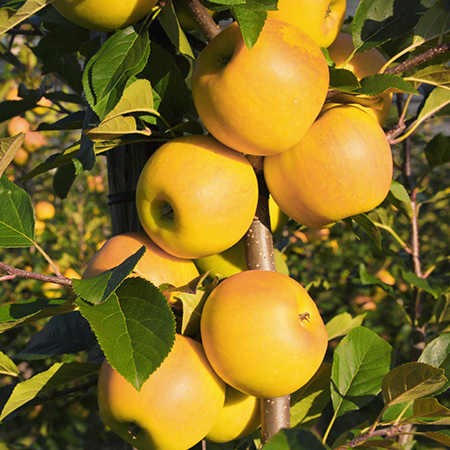
New generation of yellow variety, resistant to venturia, low levels of oxidation and bruising. Crispy, juicy and balanced in acidity to taste.
golden group

Early, improvement in color and flavor of delicious group, semi standard variety.
red group
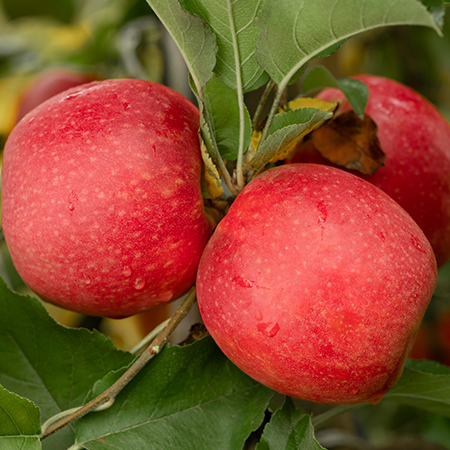
Clone of Rosy Glow with greater skill in taking cover color.
pink lady group
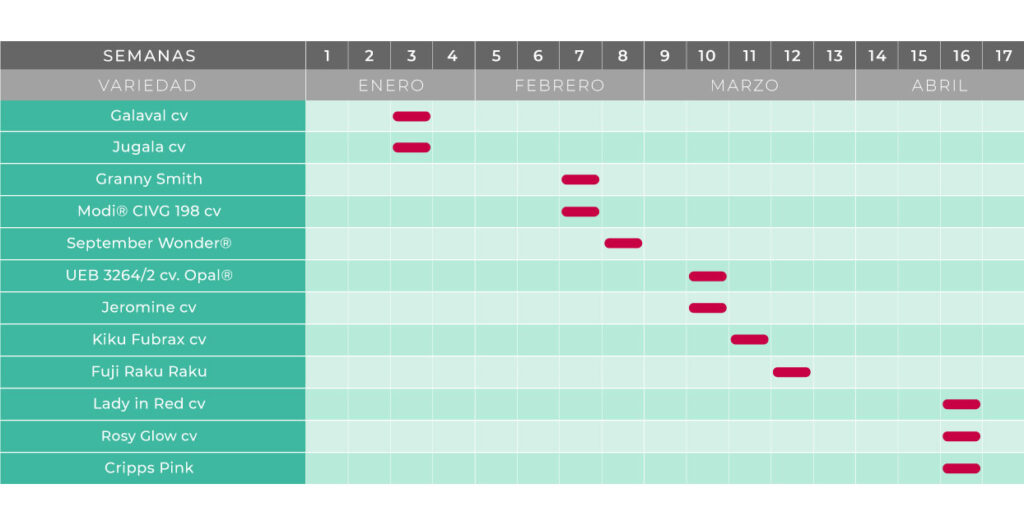
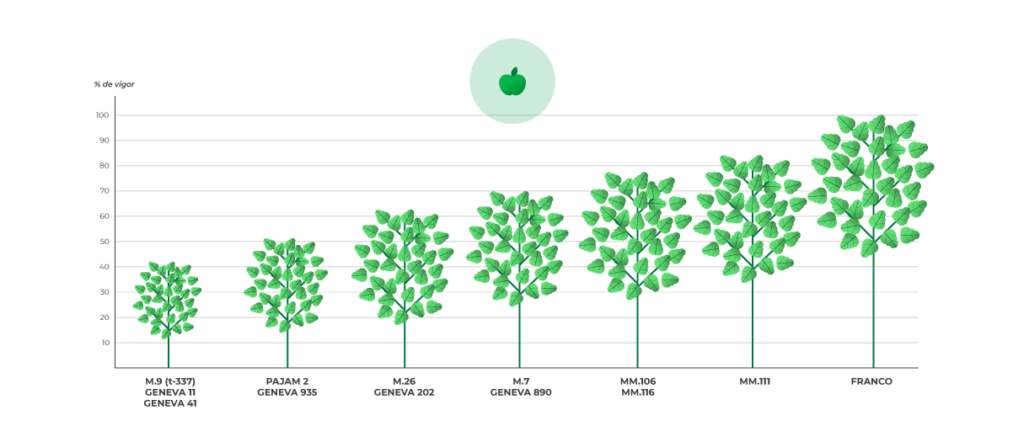
Dwarfing clonal pattern. It adapts to a wide range of soils. It has a very superficial root system. It needs structure.
Dwarfing clonal pattern. It adapts to different soil conditions. It has high tolerance to replanting situations. It needs structure.
Semi-vigorous clonal pattern. It presents an excellent response to replanting conditions. Requires no structure. Moderate resistance to Phytophthora.
Semi vigorous clonal rootstock. It is susceptible to Phytophthora. Tolerant to woolly aphids and has a high productive potential.
Semi-vigorous clonal rootstock of vigor similar to MM106. Resistant to Phytophthora, woolly aphid and suitable for replanting.
Vigorous clonal rootstock. Resistant to woolly aphids. Suitable for staking.
Clonal rootstock of similar vigor to M9-T337, very productive.
Clonal rootstock of similar vigor to M.9 Pajam 2. Tolerant to replanting and woolly aphids. Materials on the way to hospitalization.
Clonal rootstock with vigor similar to M.26, tolerant to woolly aphids, tolerant to replanting.
Rootstock vigor between M.7 and MM.106, tolerant woolly aphid, tolerant to replanting.
We deliver 1 and 2-year nursery finished plants, according to client needs, in addition to finished plants in knipp boom.
Here are the characteristics of each one.
Rootstock grafted from planting in the nursery and reared for a period of one season.
Quality | Height |
|---|---|
XL | > 1.7 mt |
L | 1.7 to 1.6 mt |
M | 1.6 to 1.5 mt |
Rootstock grafted from bench and planted in container, reared for a period of one season until delivery.
Quality | Height |
|---|---|
Super | > 1.7 mt |
XL | 1.7 to 1.6 mt |
L | 1.6 to 1.5 mt |
M | 1.5 to 1.4 mt |
Rootstock reared in the nursery the first year and grafted with the variety in the second year.
Quality | Diameter |
|---|---|
Super | > 19 mm |
XL | 16 to 19 mm |
L | 12.5 to 16 mm |
Rootstock already grafted from the start. Re-bred for a year to later be lowered.
Quality | Diameter |
|---|---|
Super | > 19 mm |
XL | 16 to 19 mm |
L | 12.5 to 16 mm |
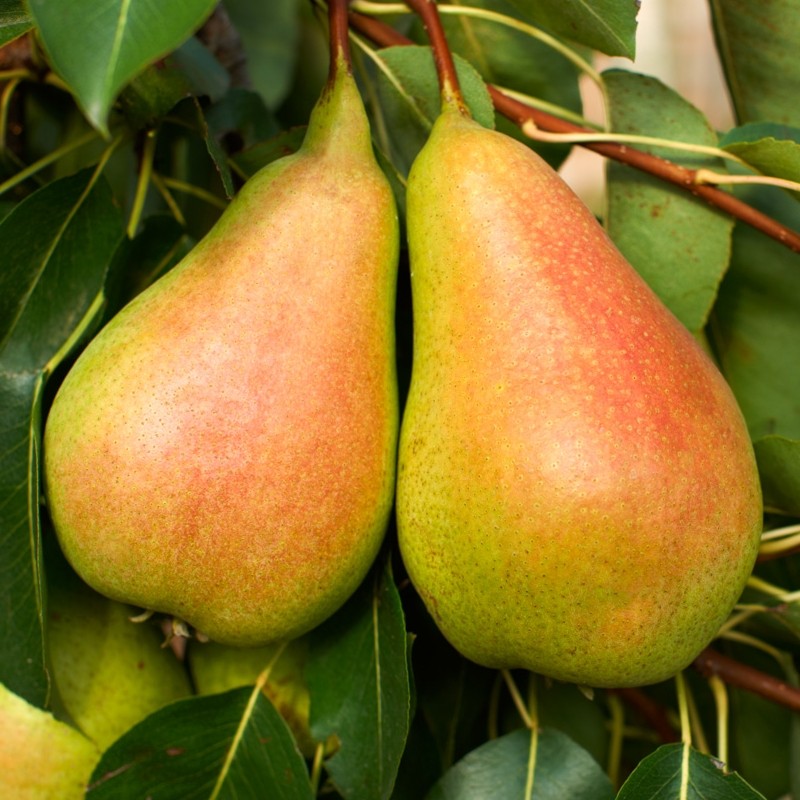
Fruit: Small, pyriform that turns yellow at maturity.
Harvest time: From the end of December to the first fortnight of January.
Production: 40 tons per hectare.
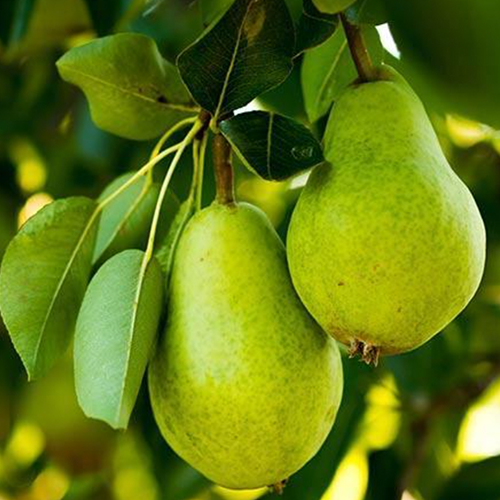
Fruit: Medium caliber, green in color.
Harvest time: End of January.
Production: 60 tons per hectare.
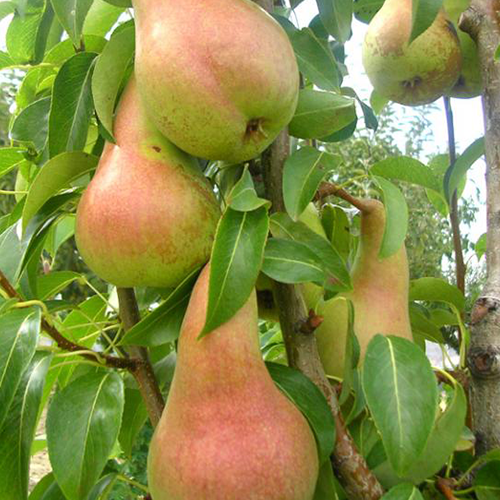
Fruit: Large and elongated, turns yellow at maturity.
Harvest time: Beginning of February.
Production: 60 tons per hectare.
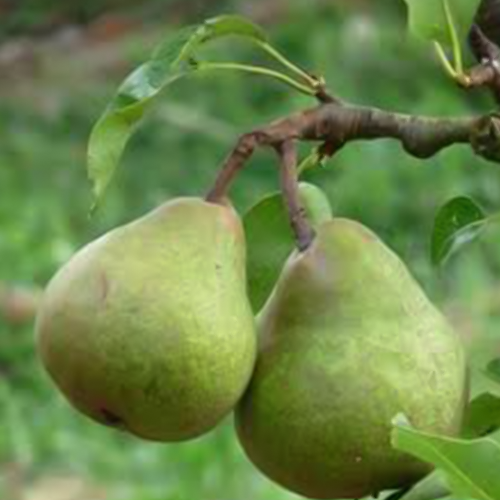
Fruit: Medium caliber, green in color.
Harvest time: Beginning of February.
Production: 80 tons per hectare.

Fruit: Elongated piriform, brown in color with russet at maturity.
Harvest time: Early February.
Production: 40 to 50 tons per hectare.
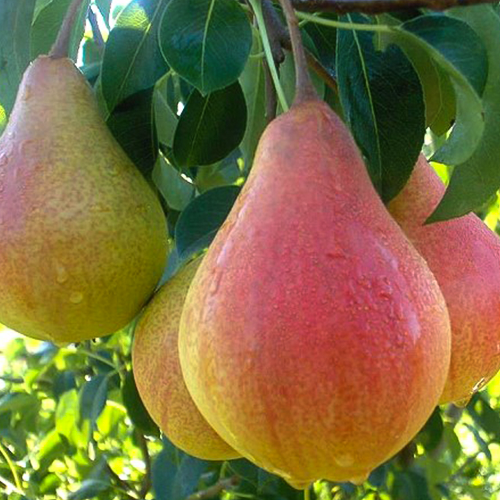
Fruit: Medium to small in size with a yellow bell shape with a red blush at maturity.
Harvest time: Between the first and second week of March.
Production: 40 tons per hectare.

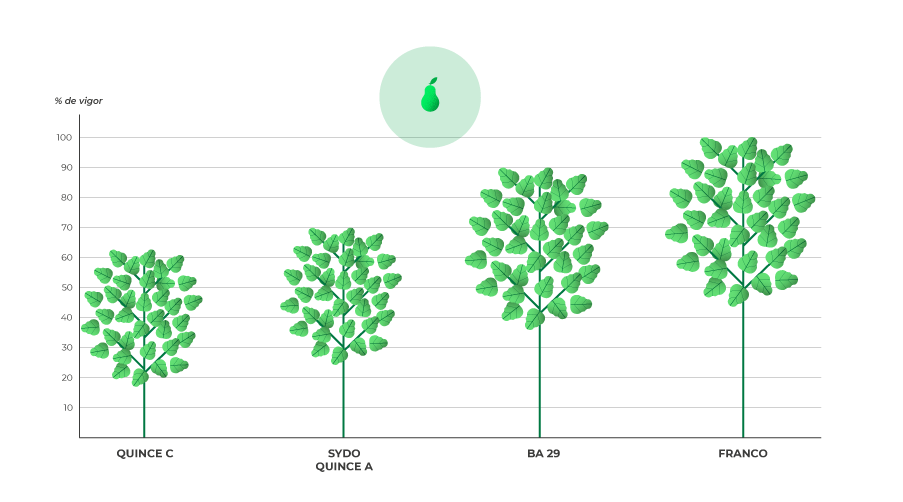
Since the use of quinces as rootstock for common pear began, it became evident that some varieties did not grow well and showed symptoms of premature senescence and even the death of the tree, which was defined as incompatibility in the union of the graft, where this is corrected with the use of a bridge graft of the Beurre Hardy or Old Home varieties due to their high compatibility with commercial varieties and quince.
We currently offer 3 plant qualities, according to the diameter of the trunk of 5 cm above the graft.
Rootstock reared in the nursery the first year and grafted with the variety in the second year.
Quality | Diameter |
|---|---|
Super | > 19mm |
XL | 16 to 19 mm |
L | 12.5 to 16 mm |
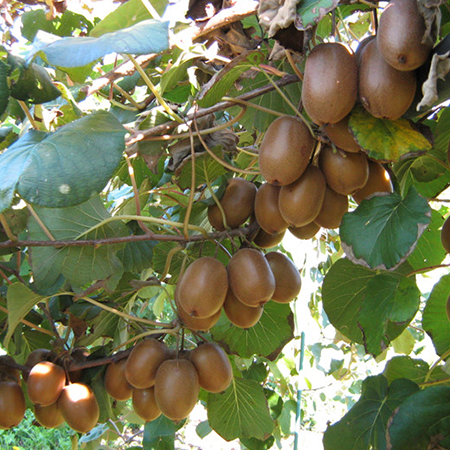
Protected variety Biogold South America S.A. consortium of which Vivero Los Olmos is authorized propagator.
Variety of yellow fruit. Early harvest.
Yellow

Plant of medium vigor, late flowering and productions of approximately 30 tons per hectare. Harvest and late ripening.
green
Very vigorous plant and proliferates. It begins to flower about two to four days before Hayward.
Vigorous plant, intermediate flowering. It begins to flower two to four days after Hayward.
Vigorous plant with a long flowering period.
It manages to cover the entire flowering period of Hayward.
Very vigorous and rustic plant, interesting cultivation due to the use of its seeds as rootstock due to greater vigor and uniformity of seedlings in the nursery.
We currently offer 2 containerized plant formats:
Sleeping eye grafted plant on a 1 year old rootstock, in a 5 liter container with substrate developed in the Nursery that allows a great root exploration.
The plants are delivered by having a vigorous bud of the variety from 10 cms. Tall.
Quality | Height |
|---|---|
Variety bud | 10 cm |
Plant in a spring container, which is reared during the spring - summer, originating a finished plant.
Quality | Height |
|---|---|
Finished ground floor | 80 cm at 1 mt, thickness 7 mm. |
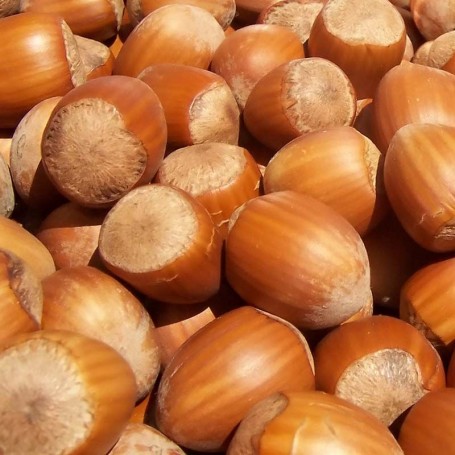
Source: Italy.
Increase: Fast.
Vigor: Intermediate.
Productivity: Productive precocity, notable proteandria and self-sterility.
Flowering: Very early.
Fruit: Average of 2.8 nucules per group.
Involvement length: Long, globular shape.
Color: Dark brown.
Roundness index: one.
Average weight: 2.5 g.
Seeds: 1.16 g average.
Shelling performance: 46% - 47%.
Peeling or Blanching of the perisperm: High.

Spread in central and southern Chile.
Vigor: High.
Productivity: High, dicogamy, proteandria and late budding.
Flowering: Early.
Fruit: 3.2 fruits per group.
Involvement length::
Long, with a good detachment.
Color: Dark brown.
Average weight: 3.5 g.
Seeds: 1.5 g average.
Shelling performance: 39% - 42%.
Peeling or Blanching of the perisperm: Intermediate.
Pollinators:Daviana, Butler, Trebizonda and some local ecotypes like Red, Blue, Brown and White.
We currently offer 1 format of bare root plant:
Young from a strain reared for 1 year.
Quality | Height |
|---|---|
XL | About 1.6 mt. |
L | 1.4 - 1.6 mt. |
M | Less than 1.4 mt. |
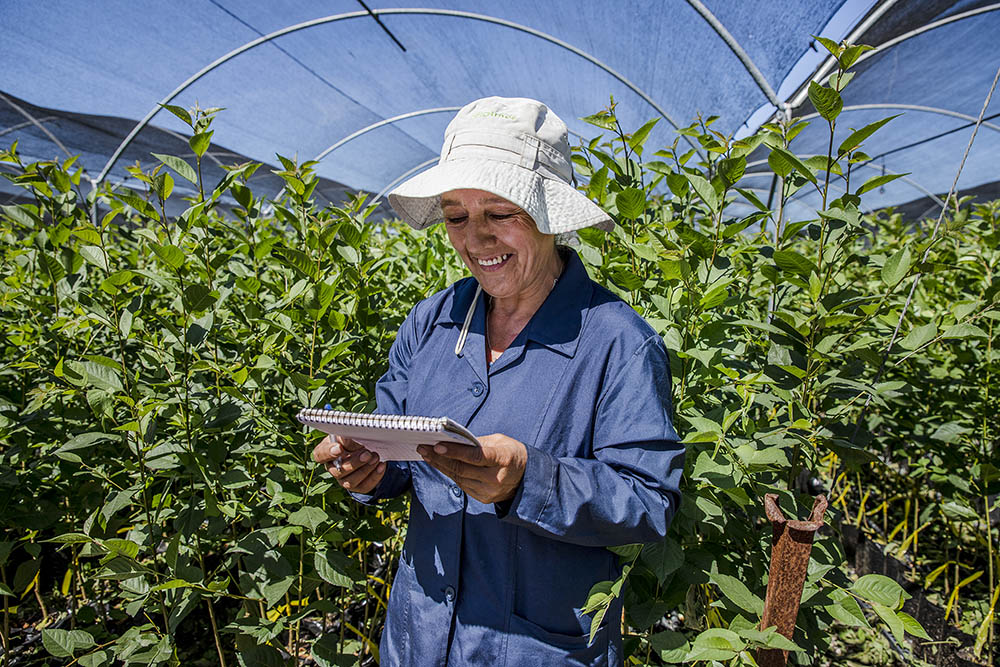
Our commitment with clients is to give them an excellent experience, that’s why we have after-sales attention, where we offer technical support and delivery of personalized recommendations to successfully carry out each client’s planting and crop development program.

In order to comply with the above, we have professionals in the field that meet the following pre and post planting visits:
- Prior visit.
- Fallow check (bare root), acclimatization check (spring bag).
- Plantation visit.
- Budding visit (bare root).
- Development visit (spring bag).
More than a service, we care to cultivate our relationship to be the partner that our clients need.
Thomas Pfeil
